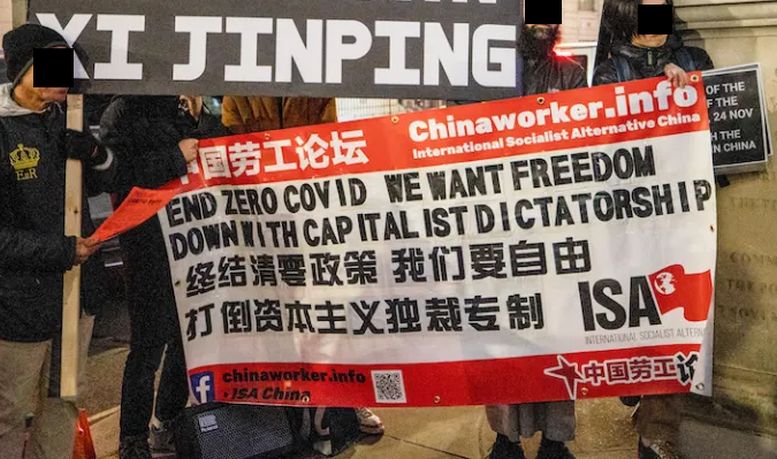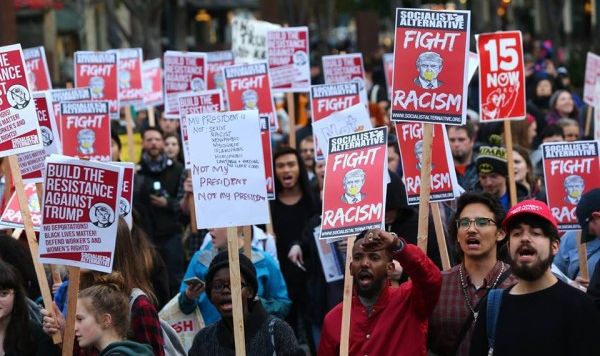Per Olsson is a member of Socialistiskt Alternativ (ISA in Sweden).
Review of Chinese Imperialism and the New Cold Warm Vincent Kolo,
To understand the dangerous new world order that is emerging, Chinese Imperialism and the New Cold War, written by Vincent Kolo, chinaworker.info (International Socialist Alternative, ISA, in China) is a must read. The book, which is a compilation of 16 articles previously published by chinaworker.info and ISA and its forerunner CWI provides a background and explanation of the new cold war raging between US imperialism and Chinese imperialism.
The new cold war has nothing to do with democracy vs authoritarianism but is a is a power struggle between two imperialist blocs over who should be number one in the world. And this struggle and power contest, as the book states, has taken “the World into a new era of extreme uncertainty and danger. It has slammed the process of capitalist globalisation into reverse and unleashed a military build-up not seen for half a century.”
Using Marxism as a tool and long before anyone else, chinaworker.info exposed and analysed the processes leading to today’s new cold war and deglobalisation. Its analyses provide a unique insight into contemporary China and the causes of its deepening crisis.
The new Cold War will be protracted and neither side think they can afford to back down, other than temporarily. Both American and Chinese imperialism regards this is an “existential struggle” in which strength will be rewarded and weakness will be punished.
For a long time, China and its rapid capitalist development were praised as a model. As recently as 2017, China’s new emperor Xi Jinping was hailed at the meeting of the global capitalist establishment in Davos, Switzerland as a “champion of free trade and globalisation.” “World leaders find hope for globalization in Davos amid populist revolt”, wrote the Washington Post at the time, January 2017, and in the article, Fred Bergsten, the former director of the Peterson Institute for International Economics, who has advised several US governments, said: “If we look back five years from now, 10 years from now, you could say this was a turning point, at which China did move up in the direction of asserting the kind of global leadership role that the U.S. has had for about a century and might willfully be abdicating.”
It’s hard to find a more erroneous forecast. A year later, US President Donald Trump started to implement trade restrictions on China, which responded with its own restrictions on US imports. Since then the new Cold War has been heating up and the two rival superpowers have formed blocs. “A bloc dynamic, the dependence of weaker imperialist states on the very strongest, has taken hold and consolidated processes around the two poles of U.S. and Chinese imperialism,” writes Kolo.
The New Cold War is more complex and potentially more dangerous than the old. The old Cold War was between two blocs based on different socio-economic systems, but the share of the Stalinist bloc, the allegedly ‘socialist’ one, in the world economy was small. Unlike the Stalinist Soviet Union, Chinese capitalism and imperialism also pose an economic threat to US global hegemony. China is the world’s second largest economy and the largest exporter and is deeply integrated into the value and supply chains of the global economy. China is also the world’s second biggest military power and its navy has more warships than the US Navy. It is therefore quite common nowadays to hear warnings like this one in The Atlantic on 9 August: “A New Cold War Could Be Much Worse Than the One We Remember.”
However, this new Cold War and the end of the world order formed after the collapse of Stalinism did not take chinaworker.info and ISA by surprise. On the contrary, as the book’s many articles show in black and white, it was predicted that the inter-imperialist tensions that followed in the wake of the crisis of capitalism, especially after the financial crisis of 2007–09 and Obama’s “pivot to Asia” in 2011, were likely to turn into a new Cold War. As early as 2012, the article “What’s behind the Japan-China Island dispute?”, warns that the region’s elites are playing with fire and that the growing tensions between the countries could result in a new cold war. And in the article “South China Sea conflict: a socialist analysis” written in June 2016 it was time to conclude that: “This does represent the start of a New Cold War between the two superpowers especially in the Asia-Pacific.”
However, the ties that were forged between the US and China after US President Richard Nixon’s visit to China in 1972 were to change the world and contribute to the collapse of Stalinism in 1989–92. (The previous year, Nixon’s Secretary of State Henry Kissinger had secretly visited China, the subject of one of the book’s articles).
As capitalism was re-established in China, ties were strengthened, but when China’s rapid economic development also began to pose a threat to the old capitalist powers the US and Europe as the crises of global capitalism unfolded, an opposite trend began with inter-imperialist tensions coming to the fore. US imperialism’s pivot to Asia in 2011 marked a turning point with the aim of building alliances that could limit China’s growing influence in the region and its expansion abroad. Or as Obama said when he spoke in the Australian Parliament at the end of 2011: “Our enduring interests in the region demand our enduring presence in the region. The United States is a Pacific power, and we are here to stay. So let there be no doubt: In the Asia-Pacific in the 21st century, the United States of America is all in.”
The rising tensions between the world’s two superpowers were accompanied by a steady increase in the militarisation of the Pacific region, while nationalism — national security — increasingly took the driver’s seat. In the Asia-Pacific region, military spending has grown more and faster than anywhere else. Military spending in Asia and Oceania increased by 62 percent between 2005 and 2014. Since then, especially in recent years, the military race in the region has constantly reached new dangerous levels. In 2022 the combined military expenditure of countries in Asia and Oceania was $575 billion. This was 2.7 percent more than in 2021 and 45 percent more than in 2013, continuing an uninterrupted upward trend dating back to at least 1989. (Stockholm International Peace Research Institute, SIPRI, 24 April 2023).
However, Obama’s pivot could not stop the shift in the world’s economic centre of gravity and the rise of Chinese imperialism at the expense of the US and other rivals, and the trends at the time (in the late 2010s) suggested that by 2030, China would be the world’s largest economy in absolute terms. In 2017, China became the world’s largest economy in terms of gross domestic product based on purchasing power parity, PPP, while still behind the US if measured in dollars.
2017 was also the year that new US President Donald Trump imposed trade restrictions on China — started with tariffs on $8.5 billion in imports of solar panels and $1.8 billion of washing machines in 2018. This in turn was followed by retaliation from Beijing. The ensuing trade war was then taken to a new level when Trump imposed further punitive tariffs on China and demanded that US companies leave the country. Trump’s actions and desire to “make America strong again” were supported by the Democrats, but unlike Trump, the Democrats wanted to build alliances against China.
But even after the increasingly antagonistic tensions between US and Chinese imperialism turned into a trade war, chinaworker and what is today the ISA (International Socialist Alternative) were pretty much alone in describing the sharpening contradictions between the world’s two imperialist superpowers as a new cold war that ultimately concerned who would be the world’s dominant power and where different capitalist states would be forced to choose sides in an increasingly bifurcated world.
During its time in office, the Biden administration has both escalated and broadened the Cold War against Chinese imperialism, which it describes as “America’s most serious geopolitical challenger” and “most consequential threat.” And last year US imperialism launched a full-blown economic war — tech war — aiming to cripple China’s future progress in AI technology and to isolate China’s entire high-tech sector.
Japan and the Netherlands have also adopted new export controls on advanced semiconductor manufacturing equipment. “All three countries are now enforcing strict export controls on advanced semiconductor manufacturing equipment, so China not only can’t buy US chips, but it also can’t buy the equipment needed to make Chinese alternatives.” (Time Magazine, 20 July 2023).
Unsurprisingly, the Chinese dictatorship has responded with countermeasures. China has for example effectively blocked any and all corporate mergers involving a US semiconductor company that operates in Chinese markets and banned domestic companies from buying chips from the American company Micron. China has also started to restrict exports of two materials key to the semiconductor industry — gallium and germanium. The steadily escalating technology war since the autumn of last year has recently been taken to a new level with US imperialism’s decision to prohibit or restrict US investments in Chinese entities in three sectors: semiconductors and microelectronics, quantum information technologies and certain artificial intelligence systems. “Biden said in a letter to Congress he was declaring a national emergency to deal with the threat of advancement by countries like China in sensitive technologies and products critical to the military, intelligence, surveillance or cyber-enabled capabilities.” (Reuters, 10 August 2023).
It is clear that Biden seeks re-election as being toughest on China. The same pattern that we have seen in the tech war — action followed by counteraction in a steady escalation, tit-for-tat — is also evident in other areas. But an even more prominent trend, as described in the book, is the bloc formation that has taken place.
The new Cold War has not only seen an increase in protectionism, but also the process of deglobalisation being accompanied by an effort to reduce economic ties or dependence between the two superpowers. Initially described in terms of de-coupling, Western imperialism now prefers to say de-risking, but as the book explains, the content of the latter term in no way changes the direction indicated by the former. Or as was commented in a recent article in Foreign Police: “US-China De-Risking Will Inevitably Escalate. The logic of reducing dependence always ends in a downward spiral.”
Nevertheless, globalisation is over. Even the International Monetary Fund is forced to recognise that: “Free trade is taking a back seat to the geopolitical interests of powerful nations. The major powers that built and maintained the free trade system now have other priorities. This puts most emerging market and developing economies in a difficult situation. The US and China are changing the system and forcing other countries to take sides in a growing geostrategic rivalry .” (IMF blog, June 2023).
The stance of the Swedish capitalists and governments is a good example; they had long hoped to avoid taking a side. Despite an increasingly hot Cold War and the crushing of the Hong Kong democracy movement, the billionaire Wallenberg family, for example, continued to foster relations with the Chinese regime and publicly oppose the exclusion of Chinese tech giant Huawei from the Swedish 5G network.
As recently as December 2020, Jacob Wallenberg said “regrettably” the dictatorship had also taken hold of Hong Kong and become more repressive, but that this was offset by the fact that “Swedish companies are treated more fairly there (in China) now than before” (Jacob Wallenberg in a Dagens Nyheter interview, 25 December 2020). A statement that shows that the capitalists’ heart beats for business and profits — not democracy. All talk of investment and economic exchange with China contributing to democracy has turned out to be empty talk — the more capitalist China has become, the more repressive and nationalistic the regime has become.
The escalation of the Cold War, however, has forced Wallenberg, the rest of the capitalist class and the government to abandon attempts to have a foot in both camps and rally behind U.S. imperialism. In a speech in June this year, the Swedish Prime Minister Ulf Kristersson said that “China’s challenge is perhaps the greatest we [the West] have faced in modern times, and transatlantic unity is key and a fundamental value in itself.”. Then he added: “Regarding the EU’s credibility as a global actor. Our relations with and exosure to China is a matter where the EU 27 should unite. The EU’s credibility and effectiveness rests on our ability to stand up for the agreed policy and live up to our interests and values. That’s very obvious for all countries, but increasingly so also for bigger ones. Those now saying ‘why should we have to choose sides between China and the US?’ are simply asking themselves the wrong question.” (Speech by Prime Minister Ulf Kristersson at the European Council on Foreign Relations, 9 June 2023).
Swedish capitalists are preparing for reduced trade with China and almost half of Swedish companies plan to reduce their purchases from China in the next two years, despite the losses this means. Other Western countries are moving in the same direction, although the pace varies.
The new era is characterized by a global imperialist power struggle, militarism and preparations for war, concludes the book and 2022 was a turning point, the Ukraine war accelerated all processes. “The two imperialist blocs, based on the US and China, were consolidated. The gap between them widened. Russia’s invasion of Ukraine gave US imperialism a huge advantage to push back against China, not only Russia. The US strengthened its leadership of the Western bloc, expanded NATO and massively increased militarisation.”
Chinese imperialism has responded by strengthening its alliance or “partnership” with Russia, and develop its ties with the Global South launching a series of new “initiatives.” The alliance with Russia involves economic factors and military as well, but as the book remarks: “Above all Chinese imperialism needs to show, especially in the ‘global south’, that it can head a ‘strong’ alternative to the US-led bloc. Both imperialist blocs are frantically recruiting to their side.”
The Financial Times recently described Beijing’s turn to the global south as “China’s blueprint for an alternative world order.” Adding that “for the first time ever, China exported more in the early part of this year to the developing world — as represented by the countries that make up the Belt and Road Initiative — than it exported to the US, EU and Japan combined.” (Financial Times, 22 August 2023)
The escalating Cold War holds the danger of developing into a military conflict, especially over Taiwan. The book quotes the Washington Post in April this year where a commentator describes the threat of war over Taiwan as “think 1914 with nuclear weapons at the ready”.
A Taiwan war would run a very high risk of escalating and drawing in other powers, effectively becoming World War 3. And even if the risk of war is not high right now, the situation is increasingly dangerous because of the crisis of global capitalism, which inevitably tends to sharpen the new Cold War and inter-imperialist contradictions.
The war in Ukraine made it easier for the Biden administration and US imperialism to strengthen and expand its bloc against Chinese imperialism and the bloc it forms. But both the US and China, even if Xi is currently facing a bigger crisis at home than Biden, are two superpowers in crisis and unable to restore any kind of global capitalist equilibrium.
For socialists, it is important not to fall into the trap of choosing sides on the basis of “lesser evilism.” A common thread running through the book is the need to expose and oppose both Cold War camps. Because: “the Cold War, with the two imperialist blocs exploiting and further polarising already volatile situations to rack up geopolitical wins, represents a serious danger to workers and youth. This is the case even without another hot war replicating and perhaps eclipsing the horrors of Ukraine. A clear perspective, analysis and program that rejects ‘lesser evilism’ and nationalism for an internationalist and working-class position of implacable opposition to all capitalist and imperialist governments, this is the only way to ensure important struggles of the oppressed are not derailed by reaction.”
Only an organised global mass movement, armed with a revolutionary socialist programme and led by the working class, can open the way to a world free from oppression and all forms of discrimination and ensure peace.
It is such a mass movement that the ISA aims to prepare for. Join the ISA, which has a presence in around 30 countries, and which is the only Marxist, revolutionary socialist movement that has an organisation in China, as well as Hong Kong and Taiwan. Buy and read: Chinese Imperialism and the Cold War.
Chinese Imperialism and the New Cold War by Vincent Kolo can be ordered from chinaworker.info, Print edition: €9.50 plus postage, PDF-version: €6.00
Print edition also available from Socialist Alternative for $13 plus postage: [email protected]




